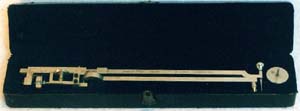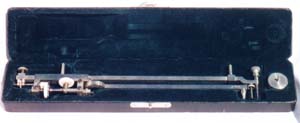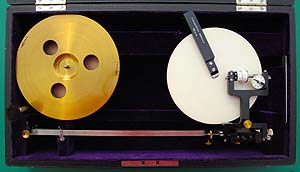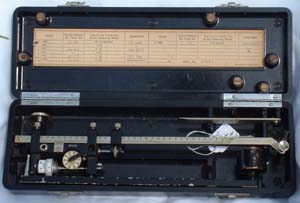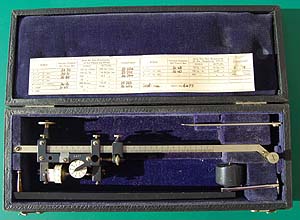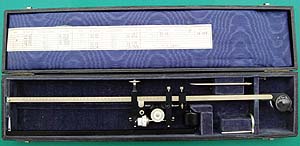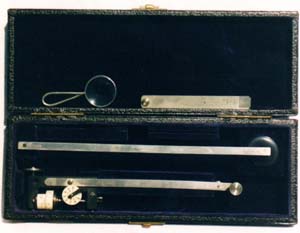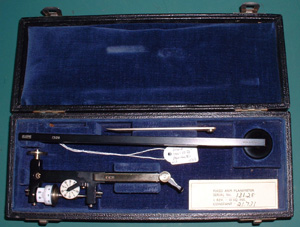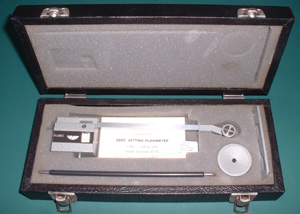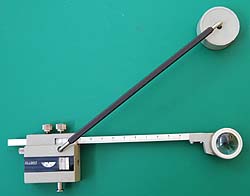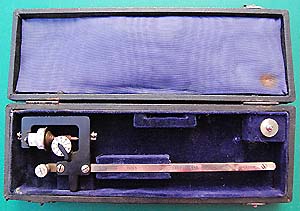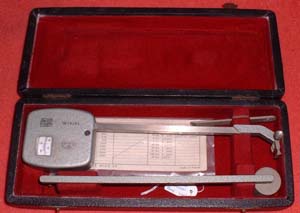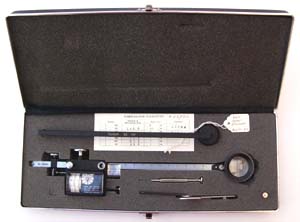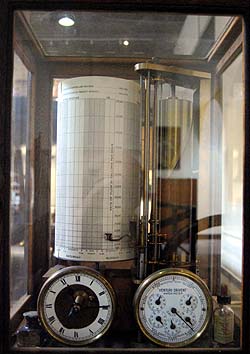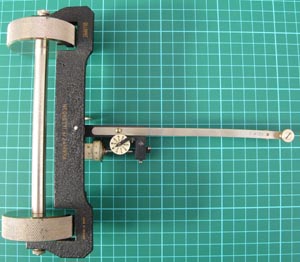













An adjustable scale, Amsler type 4 planimeter, engraved "Stanley, Great Turnstile, Holborn, London" who would have been the retailer, not the maker in this instance. It is a relatively early one, serial number 15090, dating from c1888, and has calibrated settings for a number of metric and imperial scales. A later one can be seen further down.
A fine Amsler type 2 planimeter (unsigned). This is the fixed scale (no. 2) variety, serial number 22935, dating from c1896, in German silver, calibrated for measuring in square inches. A silver plate on the lid is inscribed "A. A. Cawkwell from the officials of the Engineering Dept. Wm. Doxford & Sons Sunderland".
A signed, Amsler type 6 planimeter, serial number 81352 dating from c1939. This planimeter is adjustable to a range of metric and imperial scales. It was retailed by Dobbie McInnes, whose name is printed on the case, and it is of the special type for measuring engine indicator diagrams. By setting the adjustment such that the distance apart of the two points on the top of the instrument equals the base length of the indicator diagram, the mean effective pressure can be read directly. Dobbie McInnes are perhaps best known as manufacturers of engine indicators for steam, and low speed oil & gas engines.
Amsler compensation planimeter 612 number 11451. This adjustable planimeter was last calibrated in 1973. It is missing its checking rule
Precision disc planimeter by G Coradi, Zurich, Switzerland. The calibration slip is dated 5th October 1910. In use the top end of the arm with the maker’s name on it is placed on the centre of the large, brass weight which is knurled on its rim to rotate the white disc on which the carriage rests, presenting a smooth, matt surface for the measuring wheel to ride on. The tracing arm is graduated for a range of scales. A metric instrument obtained from Germany.
This Bakelite cased Allbrit planimeter, serial number 21681, is the adjustable type with a range of metric scales. Calibration details are recorded on the paper inside the lid. It was manufactured on 11th March 1954. I am indebted to Prof. Dr. Joachim Fischer of Ernst von Siemens Kunststiftung for this and other dating information for the planimeters in my collection.
I have another in a Bakelite case, with Imperial scales, serial number 34668, dated March 1962 on the calibration sheet.
Another adjustable Allbrit planimeter. The calibration sheet for this one (serial number 6477) is dated Sept. 1944. Unlike the one above this has a leatherette covered wooden box lined with blue velvet. It is calibrated for English units and there are several detail differences from the one above. I have also shown it assembled for use with the magnifier which can be rotated to read either the scale setting vernier or the measuring vernier. Below it is the checking bar supplied with all these instruments.
This is the large version of the Allbrit planimeter, no. 38201. It is also the less common variant with the magnifier tracer rather than the tracing point. It is calibrated for English units.
A fixed scale Allbrit B4 planimeter, also bearing the name of Stanley who supplied it to H.M. Government War Office at Woolwich on 24th April 1937 as part of a batch of six identical instruments SN 3205-3210. It is dated 1937 and its serial number is 3208. The magnifying glass for reading the vernier and the bar for checking the calibration were standard accessories. One revolution = 15 sq. inches.
Allbrit fixed scale, 1 rev = 10 sq in, planimeter, serial no. 13128. A later example than the larger model above, it dates from 1949. The calibration constant is recorded on the slip of paper in the bottom of the box.
This W F Stanley "Allbrit" "Zero-setting" planimeter bears the serial number 04768 and probably dates from the 1970s as the Q series was introduced in 1972. I also have the instructions which state that the instruments are no longer separately calibrated as they are accurately made to all have the same calibration. It is a fixed scale model and 1 rev = 100 sq cm.
This is the adjustable version of the Allbrit Zero-setting planimeter, serial number 01109. Instead of having a tracing point like the one above this one has a magnifier tracer with a fine circle in the centre. It has a foam lined case and checking rule.
W F Stanley “Allbrit” radial planimeter no. 19763 dating from ca. 1952. Scale 1 rev = .4” radius. These planimeters were used for finding the mean radius of circular charts. Originally it would have been supplied with instructions, a magnifier, and a special board.
In the top right hand corner is a chart centre. The arm of the planimeter has a groove in its underside, which slides along over the ball on the top of the chart centre as the tracing point is moved to follow the plot on the chart.
A planimeter by R & A Rost of Austria dating from 1967, type 641. It is a fixed scale 1:1000 planimeter complete with calibration bar, instructions and calibration certificate. The mechanism is essentially the same as in the Allbrit B4 but it is cased and the instrument has a silver crackle finish. Serial number 16204.
Teknor 95 IMP zero setting compensating polar planimeter, serial no. 33940. This instrument has a metal case, instructions and the following accessories: setting bar, screwdriver, allen key and spare pole point. An adjustable planimeter, made in Japan. It is actually a Koizumi KP-27 planimeter and dates from c1972.
I have a similar Koizumi KP-27 planimeter, branded Uchida, serial number 65753. In addition to its case, accessories and instructions it has an outer card box.
A linear, square root planimeter, made of brass & steel, by Geo Kent Ltd, London & Luton, 8767/71. It is housed in a fitted mahogany box. There would originally have been a rail along which it would run, being a linear planimeter as opposed to the more usual polar planimeter (which all the previous ones are). It would have been used for evaluating flow rate charts. In use the arm with the knob on was moved such that the pointer on the other arm (moved by a cam following a curve on a plate attached to the first arm) followed the diagram. The shape of the curve followed by the cam was such that the mean flow rate & hence total flow over the period would be evaluated.
A Geo Kent ‘Venturi’ water flow rate meter in the Kew Bridge Steam Museum. The vertical axis of the chart is water flow rate and I have included this picture as this is the type of chart that my planimeter would have been used with. The non-linear nature of the vertical ordinate can be seen on the chart on the drum. This chart records flow rates of up to 170.000 gallons per hour over a one week period.
Basically a Venturi meter measures the pressure increase as the water passes through the throat of the meter. The flow rate is proportional to the square root of the pressure increase.
There are other Kent flow rate meters in the museum, some of which have a larger diameter drum. They were used at water pumping stations to record the rate and amount of water pumped.
An Allbrit planimeter pole wagon in use with Allbrit planimeter 3208. The wagon also has “Negretti & Zambra” on it, who would have been the retailers. It has a black leatherette covered, blue velvet lined, fitted case.
The pole wagon was used with the tracing arm of a polar planimeter so that the planimeter could be used to measure longer areas than possible in its polar configuration. It thus became a linear planimeter. The pole wagon depended on its weight, the accuracy of the diameter of its knurled wheels, and the lack of any play in its needle bearings to ensure that it followed an exactly straight line.
Polar planimeters, used for measuring enclosed areas on drawings and maps, were invented by Jakob Amsler in 1854. He was professor of mathematics at Zurich University, Switzerland, but lived and had his workshop - founded in the end of 1854 - in Schaffhausen, Switzerland.
I have also included related instruments such as the integraph and the integrator.
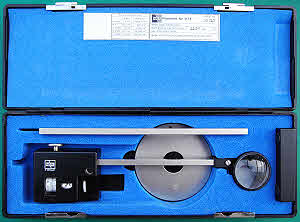
Haff type 317E fixed scale planimeter no 115720. It is complete with its instructions and checking circle.
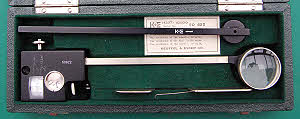
Keuffel & Esser 62 0010 compensating planimeter no.50622, ca. 1972. It is complete with checking bar and has a green card outer box.

G Coradi, Switzerland, zero setting, compensating planimeter supplied by Grab & Wilde, Zurich. It is dated 10 May 1963 on the original invoice and is also complete with its guarantee.
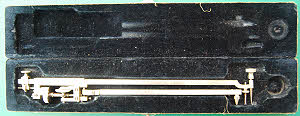

A signed Amsler type 4 planimeter that is also stamped Stanley London. A trade label on the underneath of the case shows it was retailed by W F Stanley’s Glasgow branch. Serial no.62252 dates it to the mid-1920s. It is missing the pole weight and the one shown in the left hand view is borrowed from my type 6.
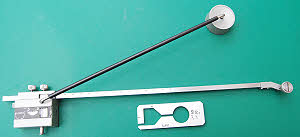
The large version of the Stanley Allbrit zero setting adjustable planimeter. This has a standard tracer rather than a magnifier one. Two other versions of the Allbrit zero setting planimeter are shown further up the page and this has a similar, but larger case to that shown with the first of these. Serial number 05653.
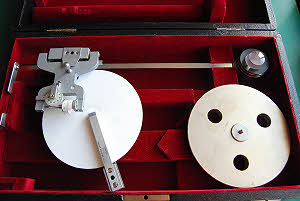
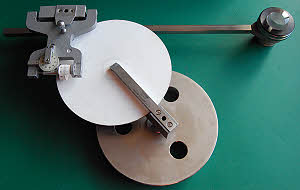
A Ott, Kempten, Bayern precision disc planimeter, type 144 4, serial number 72606, probably dating from the 1960s. The first picture shows it stowed in its case and the second, prepared for use. In use the top end of the arm with the maker’s name on it is placed on the centre of the large, brass weight which is knurled on its rim to rotate the white disc on which the carriage rests, presenting a smooth, matt surface for the measuring wheel to ride on. The tracing arm is graduated for a range of metric and imperial scales.
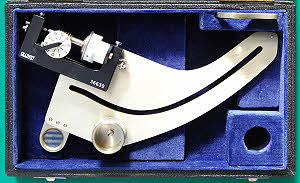
Allbrit cam-type radial planimeter for use with circular charts where the function is non-linear. These were made to order for use with a particular chart function & were supplied with a centre-stud and chart board that are now missing. Serial no. 36639. It dates from the 1960s.
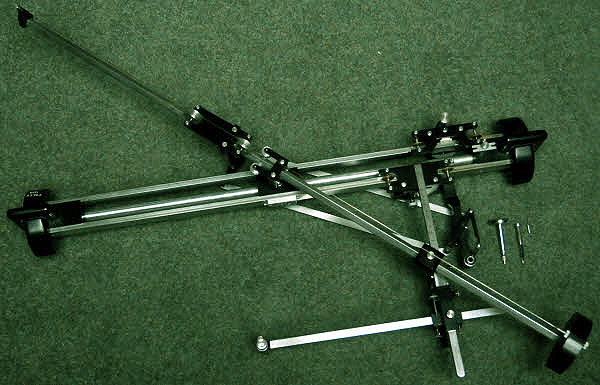





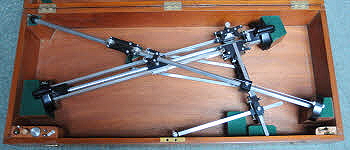
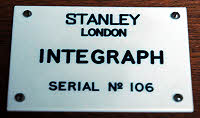
W F Stanley Integraph serial no. 106 dating from the 1950s or early 1960s probably. It is complete with pen point, pencil point and weight, container of spare leads, screwdriver, lead pusher, magnifier, and a brush. This example has clearly seen very little use, if any, as the lead container still has many unused leads in it, the pen appears not to have been used at all, and neither point fitted into the plotting arm tube until I reamed it. It is missing the handbook that would have been supplied with it. This metric version is listed in the 1958 catalogue as type A8606.
The integraph was used to evaluate definite integrals by tracing the function plot. It would at the same time plot the integral curve. This in turn could be traced to determine, for instance, the centre of gravity and plot the second integral curve. The process could then be repeated again to find the second moment of area (also known as the moment of inertia).
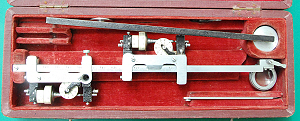
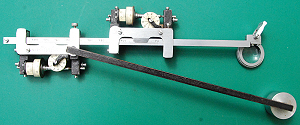
An unusual Russian planimeter that I would like to know more about. It dates from
1952. Why it has a second counter mechanism I do not know. I am certain it is original
since the box is designed to house it. It is also basically mirror image. However
it has no index mark or vernier for setting it on the bar and is held in position
by a set screw rather than a thumb screw. Apart from this additional mechanism it
is a conventional adjustable compensating polar planimeter.
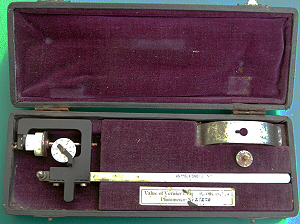
Keuffel & Esser 4215 radial planimeter no 21270 dating from ca.1950s.
On the right hand side is a chart centre. The arm of the planimeter has a groove
in its underside, which slides along over the ball on the top of the chart centre
as the tracing point is moved to follow the plot on the chart. The chart centre has
a sharp pin underneath to hold it on the board and there is a spring steel extractor
included in the top right hand corner.
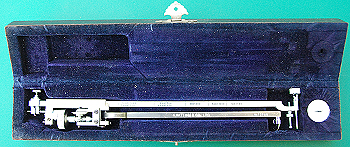
K Hattori polar planimeter no 12968. This appears to be a copy of an Amsler type
4 made in Japan.

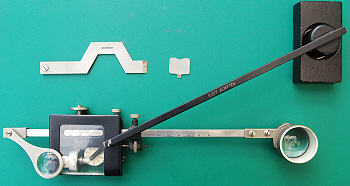
A Ott compensating polar planimeter s/n 38340 and accessories. It has a leather-cloth
covered case. It also has instruction booklets in English and German.
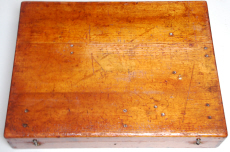
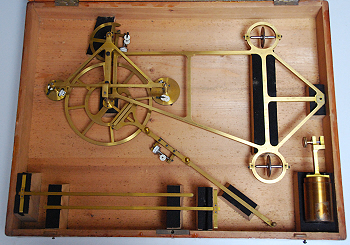
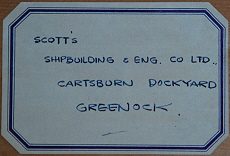
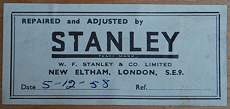

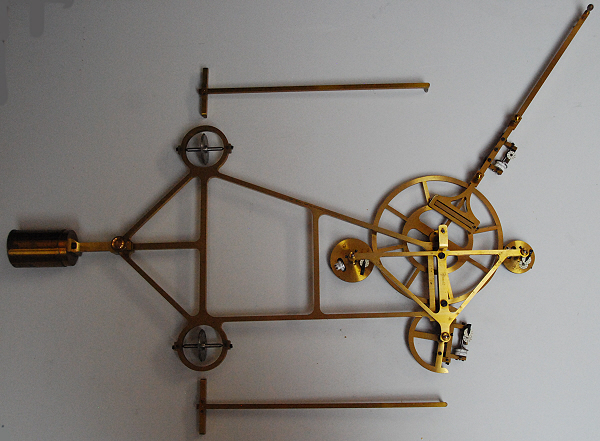
Amsler No 4 Integrator No 680 sold by W F Stanley and then on 1958 repaired and adjusted
by them Stanley further tested and calibrated the instrument in 1959 according to
accompanying documents.
This large, four roller, instrument measured the area, first moment, moment of inertia,
and the moment of the 4th order. It would originally have had a 78 inch rail, now
missing. In 1916 it would have cost £37 12s (ref. Thornton catalogue)
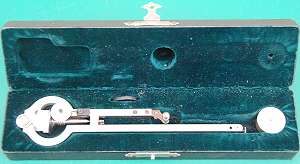
A signed Amsler type 2 planimeter This is the fixed scale instrument, serial number
68479, dating from 1927 in German silver, calibrated for measuring in square inches.
This differs from the one near the top of the page having the later type of hinge
(and associated adjusting key) and a plastic rather than metal revolution counter.
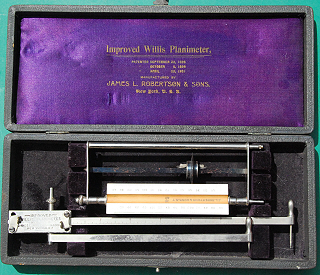
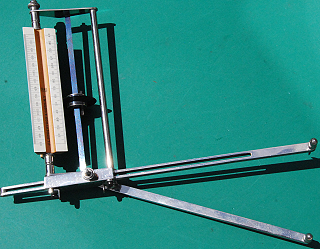
Improved Willis Planimeter manufactured by James L Robertson &Sons, NY, USA.1896,
1898 and 1901 patents listed on the lid lining. The last of these was for the triangular
rule that enabled ‘direct measurement’ of engine horsepower from the indicator diagram.
It is an adjustable planimeter with a scale of inches on the longer (tracing) arm,
for setting to the base length of the indicator diagram. The scales of 100 & 50,
80 & 40, and 60 & 30 on the triangular rule could be selected to match the spring
rating of the indicator. Serial number 1518 it dates from the early 20th Century.
James L Robertson & Sons were also makers of steam engine indicators.
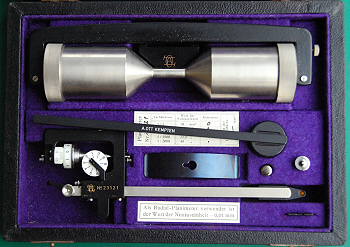
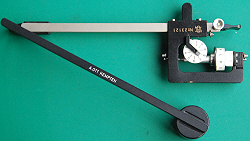

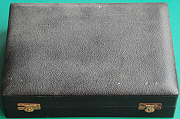
A Ott, Kempten, Bavaria, Germany Universal Planimeter S/N 23121. This planimeter
can be used in three different ways, two of which can be seen in the lower illustrations.
Firstly, for measuring areas within its range of movement it can be used as a compensating
polar planimeter, set up as in the centre picture. Where the area to be measured
is too long the tracing arm can be attached to the heavy, precision roller, when
it then functions as a linear planimeter. Thirdly it can be used as a radial planimeter
when the tracing arm, which has a groove cut in its underside, is used with the
chart centre (that it slides on) for measurements on circular charts.





